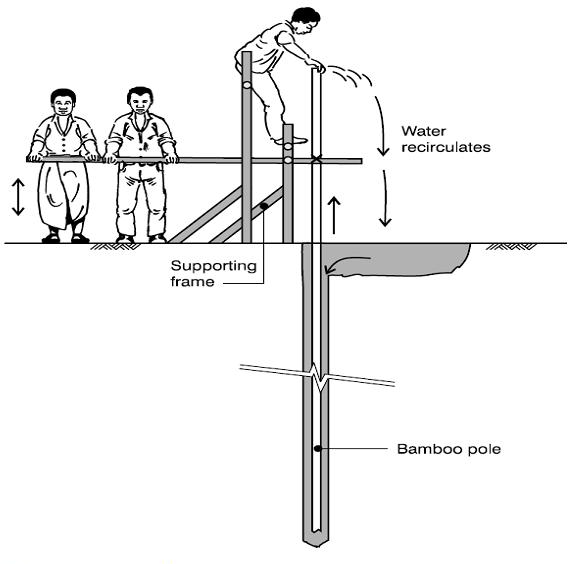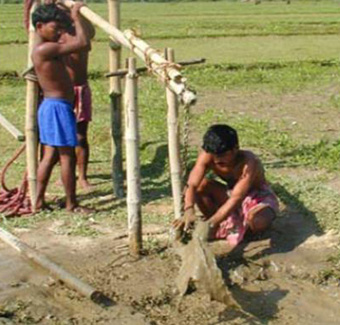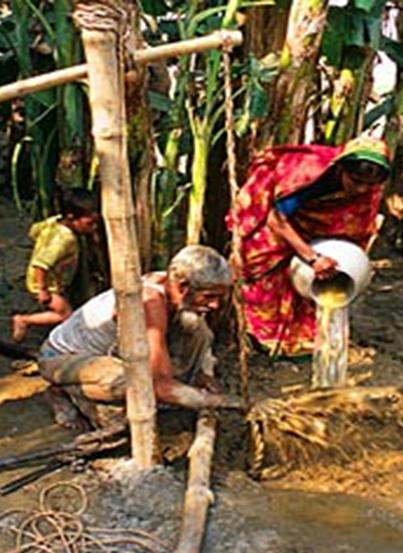Sludging - Asian sludge
Sludging is a manual drilling technique in which water is circulated to bring the cuttings to the surface. The drill pipes are moved up and down. On the down stroke, the impact of the drill bit loosens the soil and on the up stroke, the top of the pipe is closed by hand (or a valve), drawing up the water through the pipe and transporting the cuttings to the surface. On the next down stroke, the hand (or valve) opens the top of the pipe and the water squirts into a pit, in front of the well. In this pit, the cuttings separate from the water and settle out, while the water overflows from the pit back into the well.
The borehole stays open by water pressure. Thickeners such as clay, bentonite or even cow dung are usually added to the water in order to prevent hole collapse and reduce loss of working water (drill fluid).
Suitable conditions
Suitable for unconsolidated formations: Sand, silt and clay. If rotated (including a drill bit) it may be possible to penetrate softer-consolidated formations such as stiff clays, soft sandstone, and weathered laterite.
It is difficult to drill harder layers. To overcome this problem the Rota sludge was developed.
Coarse gravel and other highly permeable materials (cracks in the formation) cause loss of working water and cannot be drilled. If very fine sands (quick sands) are encountered in the first three meter of the borehole, a temporary casing and swell clay are needed on the outside of this casing to prevent collapse.
Sludging (with or without rotation) can be used up to depths of about 35 meters.
| Advantages | Disadvantages |
|---|---|
| - Easy to handle and a temporary casing is normally not needed. It is possible to construct the drilling equipment locally. - Faster as augering or percussion, as the drilling pipe can be easily extended during the drilling process, and does not need to be removed from the borehole during the process. |
- The borehole stays open by water pressure. To prevent collapsing, fluid-drilled boreholes must be kept full of water during the entire drilling and well installation process. |
Construction, operations and maintenance
Equipment is very cheap and can be produced locally.
Costs
Field experiences
Mainly used in India, Bangladesh, Nepal and Chad.
Reference manuals, videos, and links
- Rota-sludge and Stone Hammer drilling, part one: Drilling Manual by Practica Foundation. Rota-sludge and Stone Hammer drilling, part two: Production Manual by Practica Foundation.
- Drilling & well construction reference manual, Lifewater Canada, update 2004. Internet manual on hydrogeology, well construction, all drilling techniques, hand pumps and more. Download manual. Other information can be found on the Website of Livewater.
- KOEGEL, R. (1985) Self Help Wells, FAO Irrigation and Drainage Paper, FAO, Rome.ISBN 92-5-100398-X html version.
- CARTER, R. C. (2005) Human-Powered Drilling Technologies. an overview of human-powered drilling technologies for shallow small diameter well construction, for domestic and agricultural water supply , Silsoe College , Cranfield University , Bedfordshire, UK Download
- Drilling Boreholes for Hand pumps, Peter Wurzel, Skat, Switzerland, 2001 - A book on hydrogeology, well construction, drilling techniques, well development - Download. Website of SKAT
- Low-cost shallow tube well construction in West Africa, M. Sonau, FAO - An overview of shallow tube well drilling techniques - website. Website of FAO documents.
- Technical note 43. Simple drilling methods, Bob Elson and Rod Shaw, WEDC - An overview of simple drilling methods Download. Website of Loughborough University Technical Briefs section. Website of Loughborough University WELLS.
- A Water Handbook, Technical Guidelines Series, UNICEF, 1999 - Programming and implementation. Download.
- Technology notes, section 7; Tube wells and boreholes, WaterAid - An overview of human-powered drilling technologies. Download. Website of Wateraid.org.
- Multi-service procedures for well-drilling operations, field manual chapter 9, US Military Chapter 9, alternative well construction, manual drilling techniques - Download.
Acknowledgements
- The basis for the material on this page was obtained from a desk study shortly to be published on the website of the Practica Foundation, and from the Rural Water Supply Network, and specifically its manual drilling section.
- 43. Simple drilling methods. WEDC.



